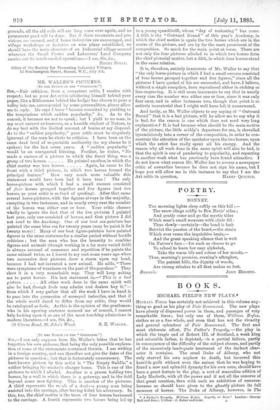[To THE EDITOR OF THE " SPECTATOR-1 can only suppose
from Mr. Waller's letter that he has forgotten his own pictures, that being the only possible explana- tion of some of the statements contained therein. I am writing in a foreign country, and can therefore not give the dates of the pictures in question ; but that is fortunately unnecessary. The best-known picture by this artist is "The Empty Saddle," a soldier bringing his master's charger home. This is one of the pictures to which I alluded. Another is a groom holding two horses, by a wall in which there is a gateway, and in the field beyond some men fighting. This is another of the pictures. A third represents the result of a duel—a young man being assisted into the carriage, after having killed his adversary. In this, too, the chief motive is the team of four horses harnessed to the carriage. A fourth represents two horses being led up
to a young spendthrift, whose "day of reckoning" has come. A fifth is the "Outward Bound" of this year's Academy, in which the chief motive is again the two horses which are in the centre of the picture, and are by far the most prominent of the composition. So much for the main point at issue. There are not only the four pictures alluded to in which two horses form the chief pictorial motive, but a fifth, in which four horses stand in the same relation.
It is, therefore, entirely inaccurate of Mr. Waller to say that "the only horse-picture in which I had a small success consisted of four horses grouped together and five figures," since all the pictures I have quoted of his are successful, and have, I believe, without a single exception, been reproduced either in etching or line-engraving. It is still more inaccurate to say that in nearly every case the number was either one or four, since it was only four once, and in other instances two, though that point is so entirely immaterial that I might well have left it unanswered.
And lastly, as Mr. Waller objects to my saying of "Outward Bound" that it is a bad picture, will he allow me to say why it is bad, for the reason is one which does not need very long explanation? It is bad because what should be the main motive of the picture, the little middy's departure for sea, is shovelled ignominiously into a corner of the composition, in order to con- centrate the attention of the spectator upon the two horses, upon which the artist has really spent all his energy. And the- reason why all work done in the same spirit will also be bad, is that the spirit is one of pandering to popularity, and repeating in another work what has previously been found attractive. I do not know what reason Mr. Waller has to accuse a newspaper critic of cowardice because he does not sign his name, but I hope you will allow me in this instance to say that I am the-


































 Previous page
Previous page